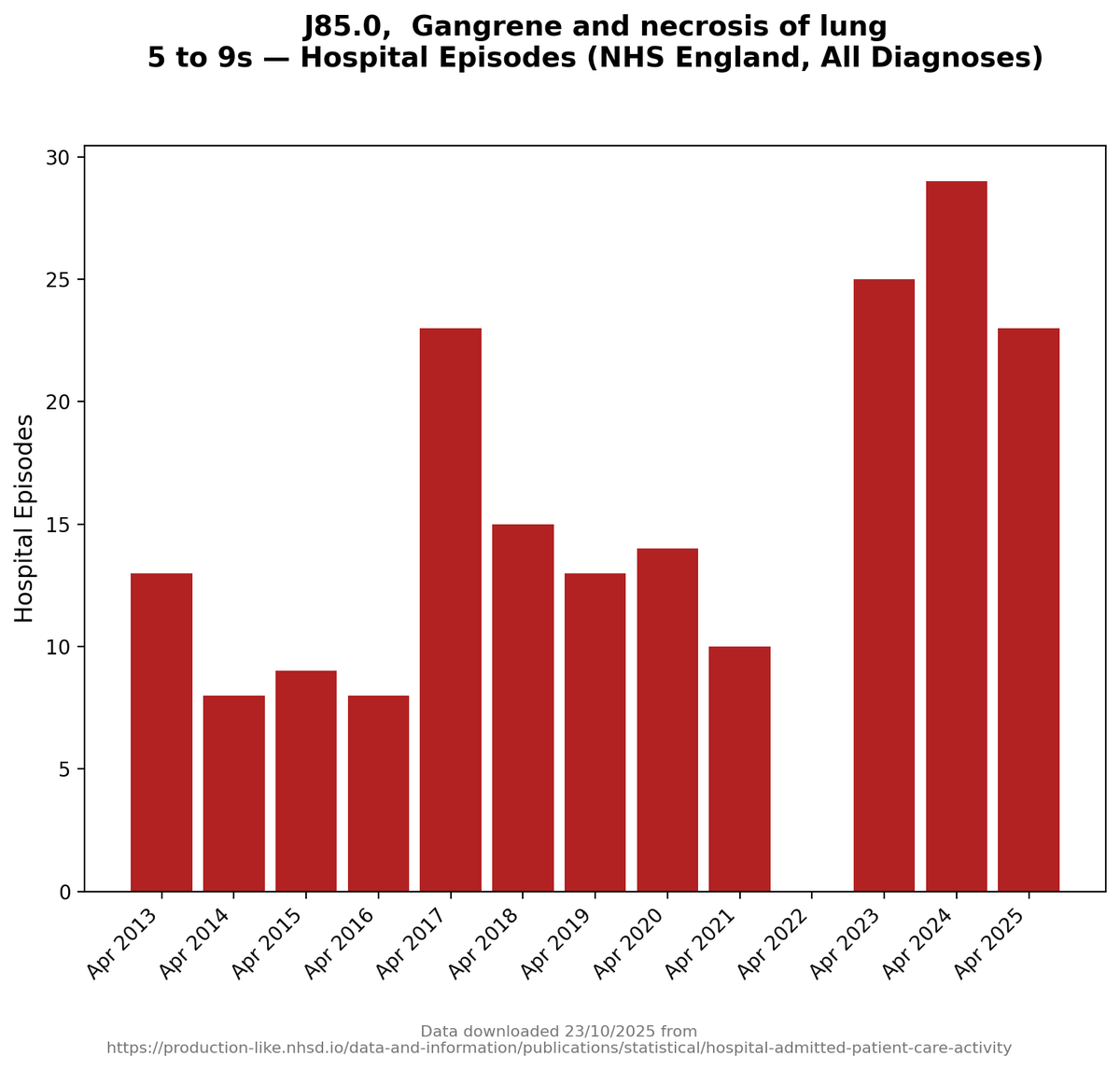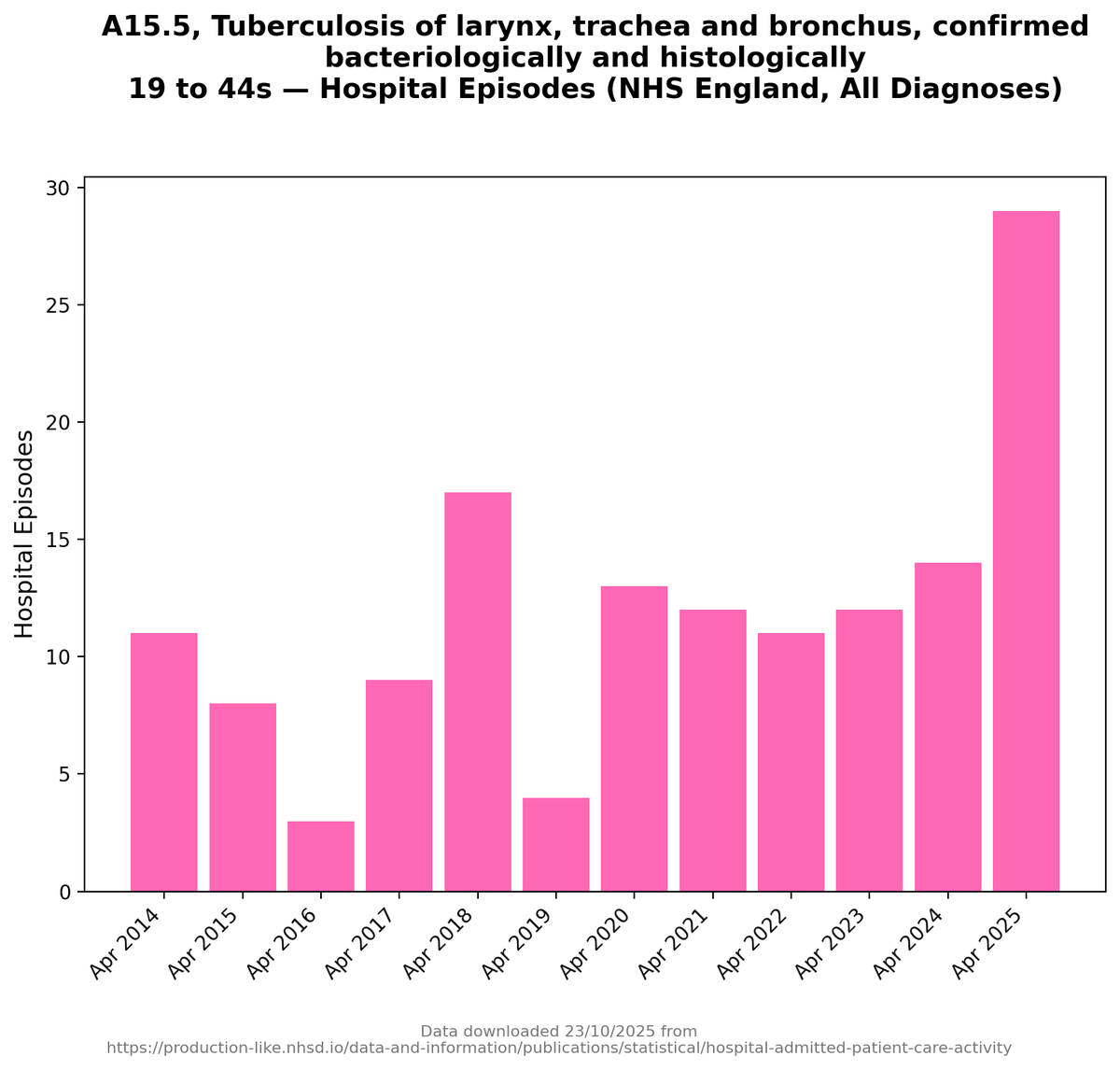Covid infection affects every part of the body, every body system, and every body function, but it *loves* the lungs.
So how does that play out in hospital episode data...
So how does that play out in hospital episode data...
And those chlamydial and mycoplasma pneumonias... they were hitting every age...
Repeat covid infections open you up to this like Trump opening up the White House to a man with a bonesaw.
Here were the big numbers for the bad boy itself, coded under 'other' because they didn't have a code for it.
These numbers have dropped, but the others are now rising.
These numbers have dropped, but the others are now rising.

But there are other alarm bells ringing too.
It's not just bacteria and viruses and atypical bacteria.
It's also...
Fungal pneumonia caused by Candida in the lungs:
It's not just bacteria and viruses and atypical bacteria.
It's also...
Fungal pneumonia caused by Candida in the lungs:

t is rare and usually happens when the immune system is weakened, the airways are damaged, or someone has been very ill. It causes cough, fever, chest pain, and low oxygen.
Covid infections make this more likely because they injure the lung lining, disrupt local immunity, and create the perfect conditions for fungal overgrowth.
Covid also increases steroid use, ICU stays, and antibiotic exposure, all of which raise the risk of fungal pneumonia taking hold after repeated infections.
Pulmonary aspergillosis is a serious fungal pneumonia caused by Aspergillus growing deep inside the lungs. It usually affects people whose immune system is weakened or whose lungs have been damaged. It can cause fever, coughing up blood, chest pain, and rapid breathing problems.
That one doesn't look like it's growing in frequency now... but let's see what comes next.
These are tiny numbers of cases of this condition... pulmonary cryptococcosis, a fungal pneumonia caused by Cryptococcus... 

It usually starts in the lungs after breathing in the spores. It can cause fever, cough, chest pain, and breathlessness, and it can spread to the brain in people with weak immune systems.
Young people shouldn't be getting it.
😕
😕
And a growing number of old people getting this one... pulmonary mucormycosis, a very serious fungal pneumonia caused by Mucor or related moulds. 

It grows aggressively in the lungs and blood vessels, causing fever, chest pain, coughing up blood, and fast-moving breathing problems. It mainly affects people with weakened immunity, diabetes, or major illness.
Covid infections make this more likely because they damage the lung lining, disrupt blood flow, and weaken immune cells that normally stop these moulds.
And some conditions come in waves... We're not in the first ever one now, but of course there are more now than before... 

Pneumocystosis, also called PCP. It is a severe fungal pneumonia caused by Pneumocystis jirovecii. It hits people with weakened immune systems, causes dry cough, fever, fast breathing, and rapid drops in oxygen, and often needs high-dose treatment in hospital.
Covid infections make PCP more likely because covid weakens T-cell function, damages the lung lining, and leaves people with long periods of impaired immunity. Steroids, antibiotics, and repeated hospital admissions after covid also raise the risk.
When the immune system is run down from repeated infections, Pneumocystis can take hold much more easily.
Pneumonias of so many different kinds.
Maybe I should have mentioned human metapneumovirus pneumonia in there too...
rising before
RISING now.
rising before
RISING now.
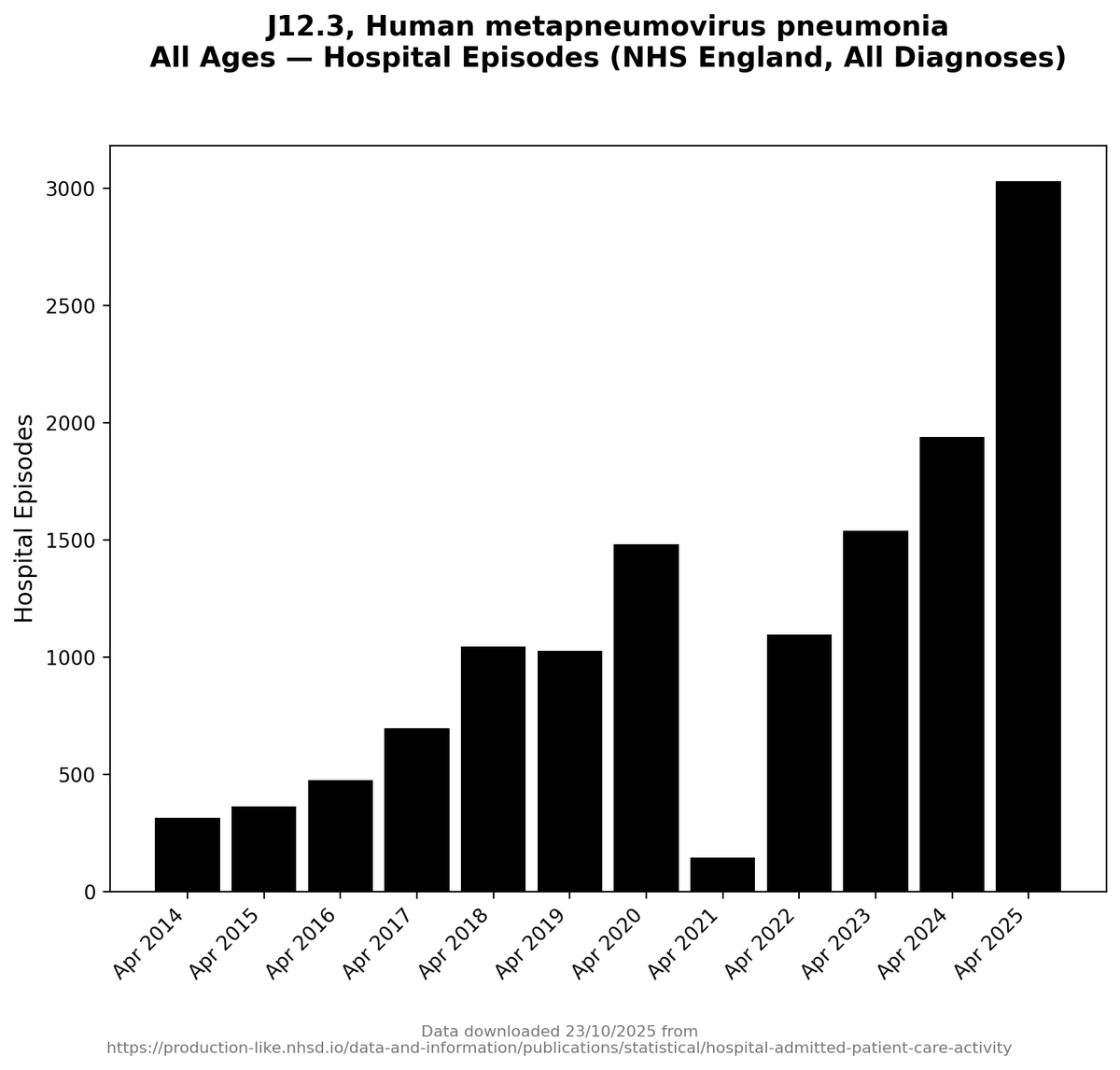
Aaach.
Onto some other lung conditions.
Onto some other lung conditions.
Panlobular emphysema, a type of lung damage where the air sacs are destroyed evenly across whole lobes of the lung. It causes breathlessness, reduced oxygen, and over-inflated lungs. 
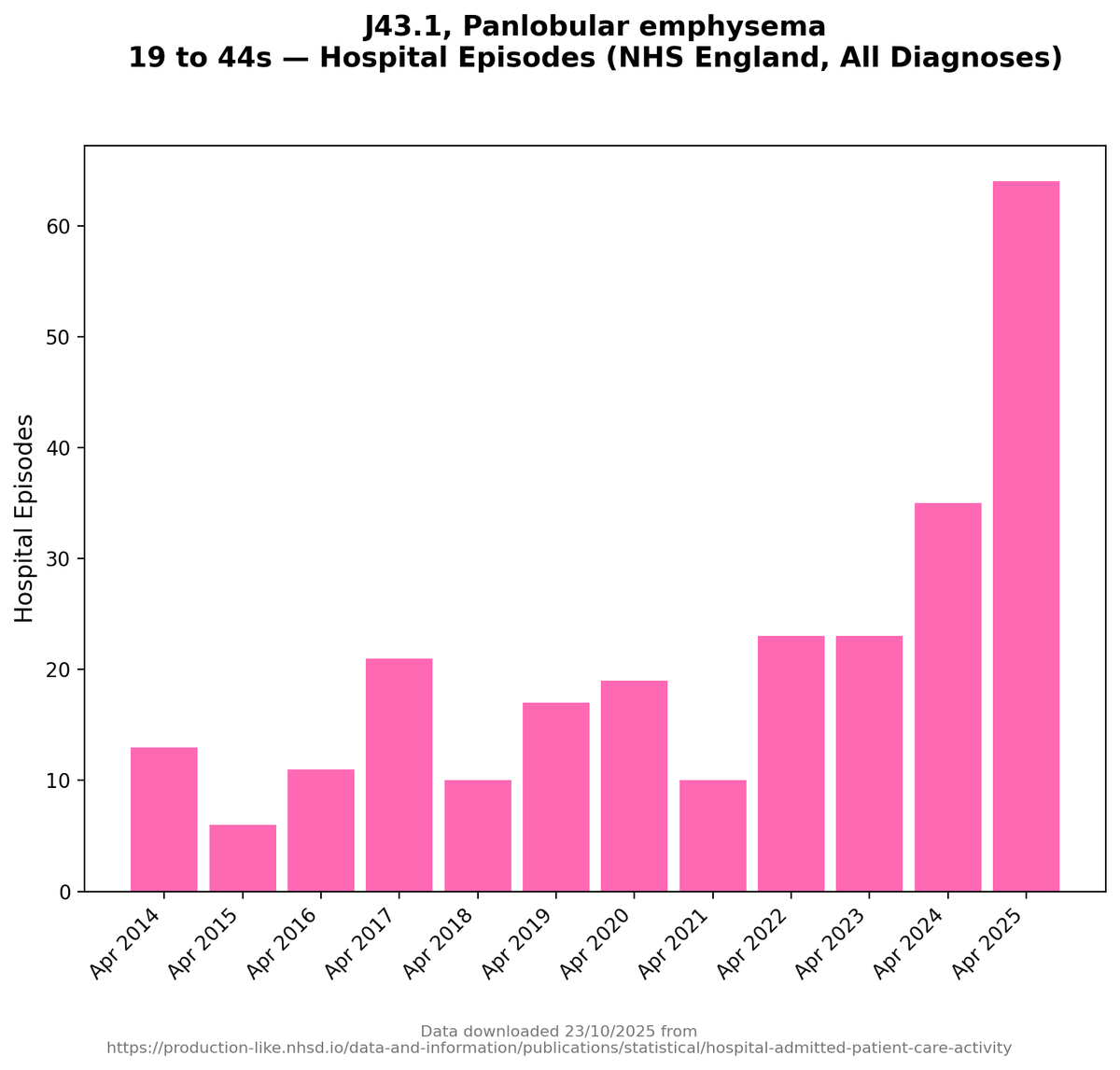
It is often linked with alpha-1 antitrypsin deficiency but can also follow long-term lung injury.
That was in *young adults*.
That's a trend we want reversed.
That's a trend we want reversed.
Mild persistent asthma. It means asthma symptoms happen more than once a week, with a cough, wheeze, or tight chest that keeps coming back. It is not severe, but it does need regular treatment to stop flare ups. 

This one is other forms of asthma that do not fit the classic mild, moderate, or severe categories. It includes asthma with unusual triggers, mixed patterns, or overlapping airway problems. People get cough, wheeze, tight chest, and flare ups that come and go. 

After covid infection, even people with stable asthma can develop new patterns of symptoms that land in this mixed category.
Teenagers with lung abscess with pneumonia... It means part of the lung has filled with pus because the infection has destroyed the tissue. It causes fever, chest pain, cough with foul sputum, and can make breathing much harder. 

And with alveolitis, inflammation of the tiny air sacs in the lungs. These sacs are where oxygen moves into the blood. When they get inflamed, the lungs stiffen, breathing becomes harder, and oxygen levels drop. It can be acute or the start of longer-term lung disease. 

*Kids* with interstitial lung disease that is not fully classified. It means the tissue between the air sacs is inflamed, scarred, or thickened. People get breathlessness, dry cough, and reduced oxygen because the lungs cannot expand or transfer oxygen properly. 

Teenagers with pyothorax without fistula. It means there is pus trapped in the space around the lung, called the pleural space. It usually happens when a bad pneumonia or lung infection spreads outward. It causes fever, chest pain, breathlessness, and fluid that must be drained. 

Covid infections make this more likely because they damage the lung lining, weaken the immune response in the chest, and allow bacterial infections to spread more easily. Covid also increases the chance of complicated pneumonias that leak into the pleural space.
When the lungs are already injured, infections are more likely to turn into an empyema that needs hospital care.
Compensatory emphysema. One part of the lung has expanded more than normal because another part has been damaged, collapsed, or removed. The healthy areas over-inflate to make up for the lost function. It's a sign the lung is trying to cope with uneven injury. 
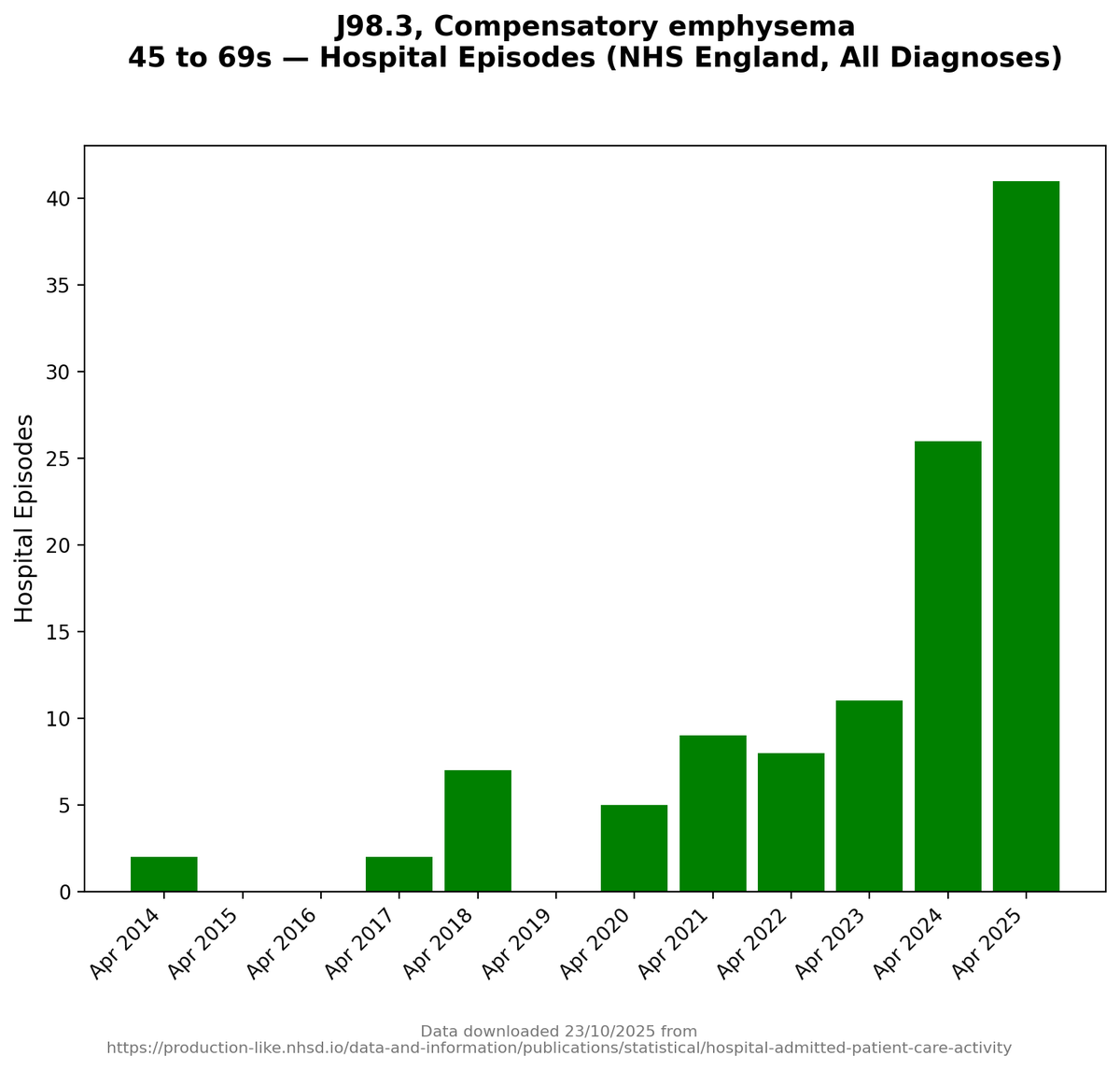
Covid infections make this more likely because they can leave patches of lung collapsed, scarred, or destroyed. When some segments stop working properly, the remaining segments expand to take over.
After repeated covid infections, this uneven damage becomes more common, so compensatory emphysema shows up more often.
"in conditions classified elsewhere" often seems to mean 'they had covid'.
It means fluid has built up in the space around the lungs, not as a primary lung problem, but as a result of something else like infection, heart failure, inflammation, or cancer.
It means fluid has built up in the space around the lungs, not as a primary lung problem, but as a result of something else like infection, heart failure, inflammation, or cancer.

The fluid makes breathing harder and often needs draining.
Covid infections make these effusions more likely because they inflame the lungs and lining of the chest, strain the heart, and disturb the tiny vessels that normally drain fluid.
Covid also triggers clots, low protein levels, and immune flare ups.
All of these push extra fluid into the pleural space, so more people end up with effusions linked to other conditions.
I don't know if covid is causing this... but it's injury from inhaling stomach acid (from sickness or reflux) into the lungs.
It's not nice for a teenager to have it either way.
It's not nice for a teenager to have it either way.

This is a 'pleural plaque' not linked to asbestos. It means a thickened, scar-like patch has formed on the lining of the lung. Most plaques are harmless and found by accident on scans, but they show past inflammation or irritation of the pleura. 

And this.
It means the lungs have become filled with eosinophils, a type of white blood cell that reacts to allergies, parasites, inflammation, or some infections.
It means the lungs have become filled with eosinophils, a type of white blood cell that reacts to allergies, parasites, inflammation, or some infections.

It causes cough, wheeze, fever, chest tightness, and falling oxygen because the air sacs get clogged with immune cells.
In the words of one friend, "It's ok - it started before Covid!!".
Pulmonary embolisms - that means a blood clot has travelled to the lungs and is blocking a major artery. The blockage is so serious that the right side of the heart is failing under the sudden pressure.
Pulmonary embolisms - that means a blood clot has travelled to the lungs and is blocking a major artery. The blockage is so serious that the right side of the heart is failing under the sudden pressure.

Covid infections make this far more likely because they increase clotting, damage blood vessel linings, and thicken the blood. Covid also raises inflammation and slows blood flow in the legs and lungs.
Even mild infections can leave people prone to clots for weeks, and repeated infections stack that risk, making severe pulmonary embolism more common.
This one means there is an abnormal connection between an artery and a vein inside the lung, so blood skips the normal oxygen exchange. This can cause breathlessness, low oxygen, fatigue, and sometimes coughing up blood. 

An aneurysm of the pulmonary artery. It means a section of the artery carrying blood from the heart to the lungs has ballooned or weakened. It can cause chest pain, breathlessness, coughing up blood, or no symptoms until it becomes *dangerous*. 

That was in *young adults*.
Covid infections make this more likely because they inflame and damage blood vessel walls, raise pressure in the lung circulation, and increase clot formation.
Repeated covid infections keep stressing the pulmonary arteries, which can make weak spots expand into aneurysms over time.
These are problems with the blood vessels in the lungs that do not fit the classic categories, such as unusual vessel narrowing, abnormal vessel growth, or odd patterns of blocked or inflamed arteries and veins.
In *teenagers*.
In *teenagers*.
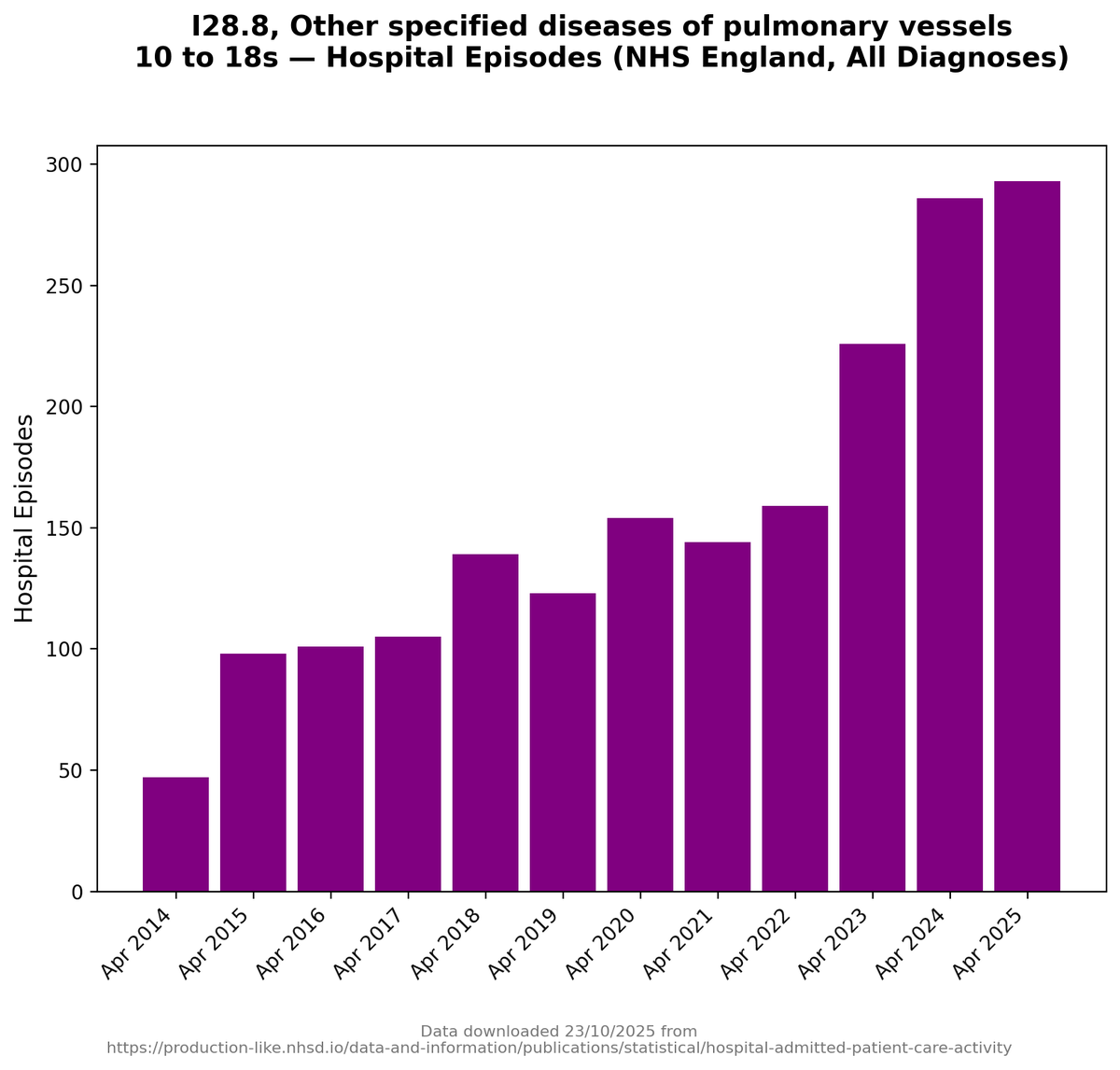
Covid infections make these disorders more likely because they damage the lining of blood vessels, trigger inflammation, and create tiny clots throughout the lungs.
Repeated covid infections keep stressing the pulmonary circulation. These small injuries add up, so more unusual or mixed vascular problems get recorded
This isn't lungs so much, as a congenital nasal septum deformity. It means a baby is born with the wall between the nostrils bent or misplaced. This can make breathing noisy or difficult, especially during feeds or sleep, and can cause long-term nasal blockage... 

Same here. This should be a birth thing.
It means a piece of lung develops without a proper connection to the airways and gets its blood supply from the wrong artery. That extra segment cannot take part in normal breathing.
It means a piece of lung develops without a proper connection to the airways and gets its blood supply from the wrong artery. That extra segment cannot take part in normal breathing.

It can cause infections, cough, or trouble with oxygen uptake.
And let's not forget tb.
Young adults.
Lung tuberculosis confirmed by culture. It means TB bacteria have been grown in the lab from a lung sample. This type of TB causes cough, weight loss, fever, night sweats, and lung damage if not treated.
Young adults.
Lung tuberculosis confirmed by culture. It means TB bacteria have been grown in the lab from a lung sample. This type of TB causes cough, weight loss, fever, night sweats, and lung damage if not treated.

Covid infections make TB more likely to show up because covid weakens immune control in the lungs, disrupts macrophages that normally contain TB, and increases inflammation that helps TB reactivate.
This one is when TB bacteria have spread through the bloodstream and formed tiny spots of infection all over the lungs and other organs. It causes fever, weight loss, weakness, and fast-moving breathing problems. It is a medical emergency. 

Covid infections make this more likely because they weaken the immune cells that normally wall off TB, damage lung defences, and raise inflammation that helps the bacteria break out of their old hiding places.
After covid, people with latent TB are more likely to tip into widespread disease like miliary TB.
Or Legionella.
In young adults again.
Covid infections make this more likely because they weaken lung defences, damage the airway lining, and reduce the immune response that normally clears early Legionella exposure.
In young adults again.
Covid infections make this more likely because they weaken lung defences, damage the airway lining, and reduce the immune response that normally clears early Legionella exposure.
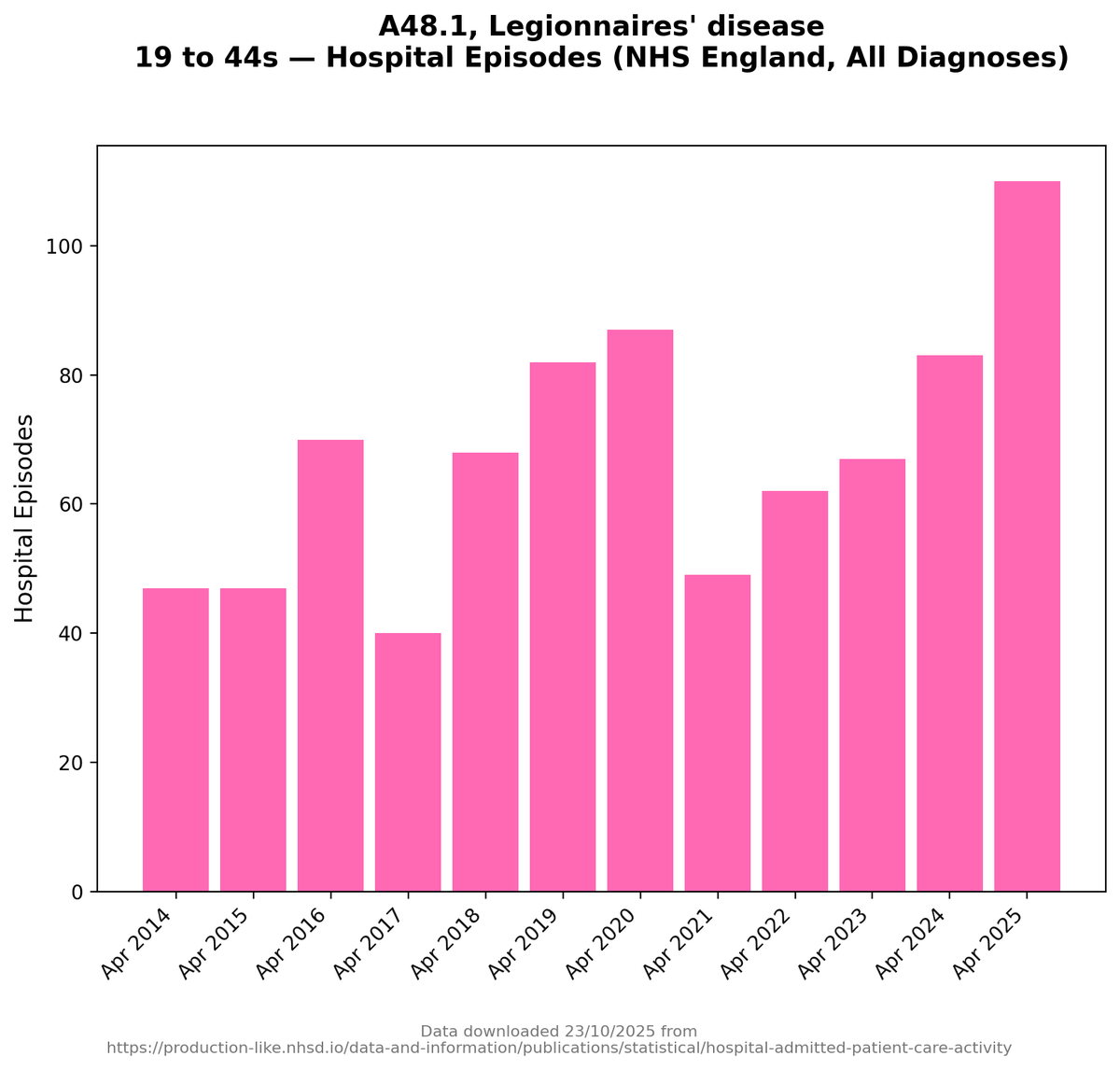
🧐
Valley Fever. It's a fungal lung infection caused by breathing in Coccidioides spores from soil in certain regions. It causes fever, cough, chest pain, tiredness, and can become severe in people with weak immunity.
Valley Fever. It's a fungal lung infection caused by breathing in Coccidioides spores from soil in certain regions. It causes fever, cough, chest pain, tiredness, and can become severe in people with weak immunity.
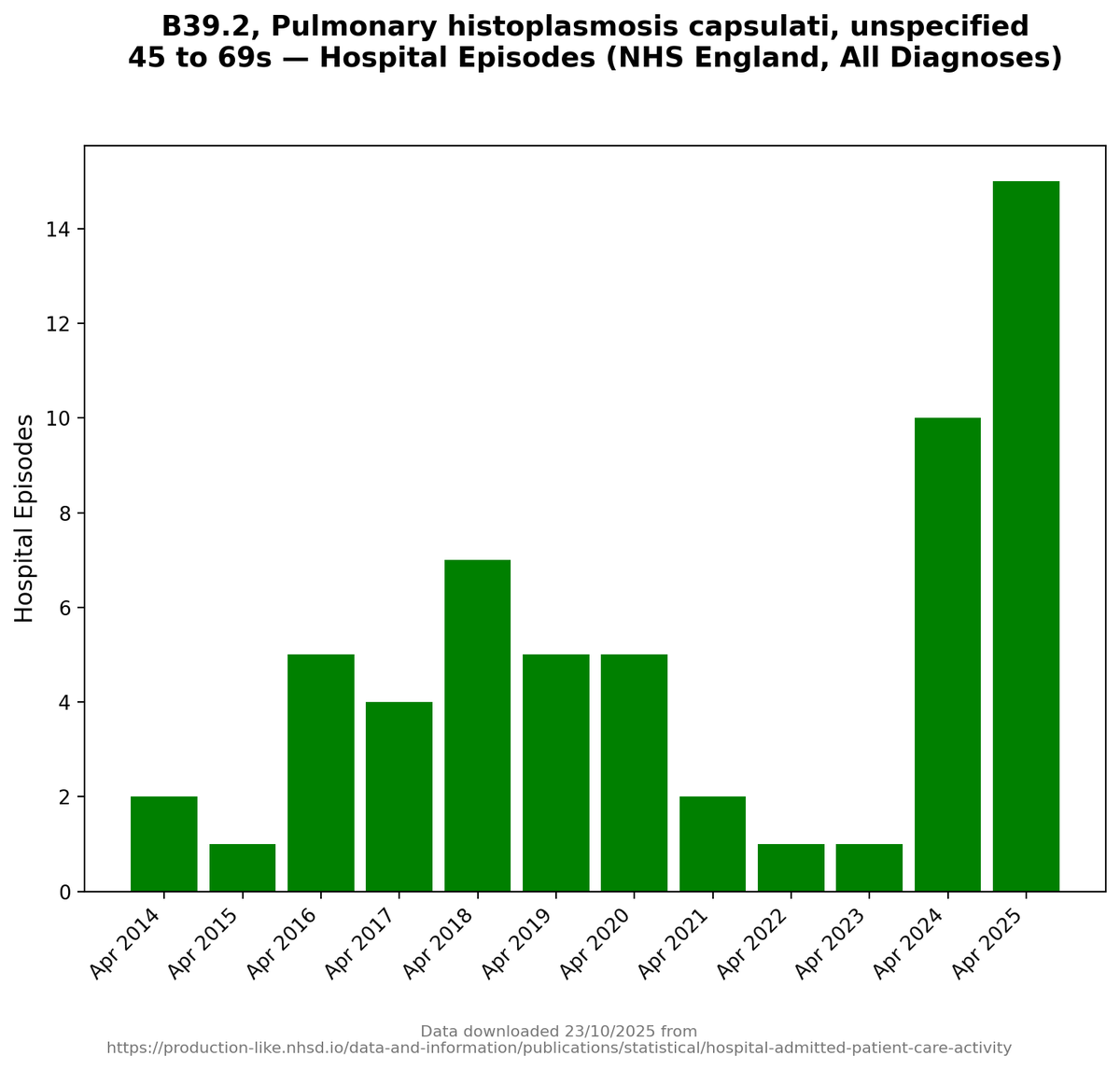
While we're here... Chagas disease with heart damage. It happens when the parasite Trypanosoma cruzi infects the heart muscle. Over time it can cause irregular rhythms, heart enlargement, heart failure, chest pain, fainting, or sudden collapse. 

Covid infections make this more likely to show up because covid weakens immune control, increases inflammation inside the heart, and damages the same tissues that Chagas targets.
Covid also increases arrhythmias and heart strain. When someone already has silent Chagas infection, covid can unmask it, speed up the heart damage, or make symptoms appear earlier.
Covid infections don't have to *cause* something to make it a problem.
They just have to take what's there and make it *worse*.
They just have to take what's there and make it *worse*.
Sorry to stray from the lungs.
Focus...
Focus...
Hydatid cysts in the lungs caused by the parasite Echinococcus. People get cough, chest pain, breathlessness, and sometimes sudden problems if a cyst bursts. It comes from swallowing tapeworm eggs, usually through contact with dogs or livestock. 

Covid infections make this more likely to appear because they weaken lung defences, inflame the airway lining, and increase the chance that silent cysts start causing symptoms.
Covid also changes immune control, so cysts that were stable can grow or rupture more easily, leading to more cases being picked up in hospital records.
Covid is causing *a lot* of cyst problems.
Yes, you can argue that there was a lot more measles last year, so a lot more reason for measles pneumonia... but still... 



So many long problems.
So many of them leaping.
Welcome to the age of Covid.
So many of them leaping.
Welcome to the age of Covid.
And don't forget.
It's not just the lungs.
It's *everywhere*.
It's not just the lungs.
It's *everywhere*.
https://x.com/1goodtern/status/1992249114290184366?s=20
• • •
Missing some Tweet in this thread? You can try to
force a refresh













